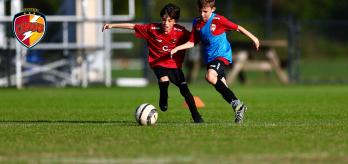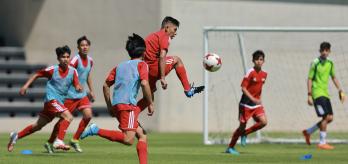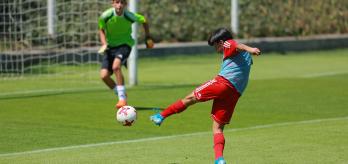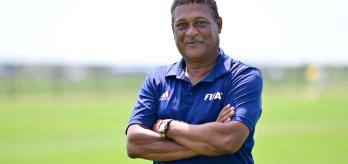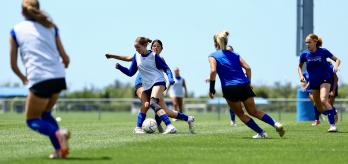The training exercises focus on the continuous improvement of four basic technical aspects: control, passing, dribbling and finishing. Ball work is the primary focus in this session, helping players from youth level to acquire basic technical skills and familiarise themselves with the ball.
Twelve years ago, Salvador Díaz launched a football project called Cefor Jilo. He greatly values the effort and motivation that the club’s youngsters are demonstrating towards its activities. His methodology focuses on performing as many exercises as possible with the ball.
The training session begins with an activation comprising physical and technical exercises in which the intensity levels are gradually increased. The aim is to prepare the players for subsequent exercises in tight spaces and in‑match situations. The session ends with a finishing exercise, both from wide areas and centrally.
Session overview
Key coaching points
-
Players must keep their heads raised as they dribble to avoid colliding with others.
-
Players should enjoy themselves and be motivated by competing with each other.
-
The attacking team must constantly be on the move and create passing lanes to retain possession.
-
Both the team in possession and the team waiting in the other zone must stay focused and pay attention to the ball and the positioning of the other players.
-
The team that lose possession must react quickly in order to transition effectively from attack to defence.
-
The attackers must time their runs into the area to run onto the ball and shoot on goal.
Part 1: activation with physical and technical exercises
The session begins with a general activation broken down into 4 parts (A, B, C and D). In part A, players combine technical and ball circulation exercises. In part B, players pair up and race against each other by dribbling at speed. Part C involves a pass-and-move circuit. Part D involves a rondo with opposition to help prepare for the session’s main exercises.
Part A: general activation and individual technique
-
Mark out an area within which the players must perform the exercise.
-
Give the players a ball‑based exercise to perform.
-
The players perform the technical exercise indicated by the coach and, on the sound of the whistle, dribble with the ball through the space.
-
Players must keep their heads raised as they dribble to avoid colliding with others.
Part B: dribbling race in pairs
-
Get the players into pairs.
-
Place a ring next to each pair, and put 2 cones opposite each other, 3m away from the ring.
-
Give the players a ball‑based exercise to perform.
-
Players start at each side of their ring.
-
When the coach blows the whistle, each player dribbles as quickly as possible to one of the cones and races back to trap the ball inside the ring. Each player aims to complete the sequence before their partner.
-
The players get themselves into groups of 4. Two players dribble from the ring to a cone and back again, before passing to a team-mate stationed at the cone, who then dribbles the ball to the ring and traps it inside the ring.
-
Players should enjoy themselves and be motivated by competing with each other.
Part C: simple passing circuit
-
Create a circuit with 4 small gates and 2 cones, which mark each station, as shown in the image.
-
The players located at the first cone begin the exercise.
-
One player is stationed at each cone and 1 player behind each of the 2 gates located parallel with the first cone.
-
Player A, who is stationed at the first cone, passes the ball to player B, stationed at the opposite cone.
-
Player B returns the ball and moves to one of the gates located diagonally to the cone.
-
Player A passes the ball through the gate to player B, who performs a directional control and plays a pass through the final gate to player C.
-
Player C joins the players at the first cone.
-
Ask the players to perform the circuit by playing one‑touch only.
Part D: 6v2 rondo using two playing zones
-
Mark out 2 playing zones, 6 x 6m each.
-
Arrange the players into 4 teams of 2 players each.
-
Three teams are placed inside the first zone, 2 of which are tasked with keeping possession while the other team try to get the ball off them.
-
The fourth team are placed in the other zone.
-
This exercise creates a 4v2 situation. The 4 in-possession players try to complete 5 passes to progress to the second zone, where the 2 players in that zone should retain possession and continue the move.
-
When the defending team win possession of the ball, they become the attacking team. The player who misplaced the pass and their partner become the defending team.
-
The sequences should be performed at a high tempo but should also remain short to allow the players to recover.
Part 2: 6v3 exercise in reduced-sized playing areas
Part 2 works on possession in reduced spaces, with a 6v3 numerical advantage in favour of the team in possession. In this exercise, the team in possession seek to complete 6 passes and then switch the play to the adjacent zone. The defending team aim to recover the ball quickly and thus become an attacking team.
-
Mark out 2 playing zones, 15 x 25m each.
-
Arrange the players into 3 teams of 6 players: blue, orange and yellow.
-
In between the two playing zones, create a transition zone of 2 x 25m, from where 3 players will enter the playing zone to recover the ball.
-
The blue and orange teams start in the playing zone.
-
The yellow team are set up as follows: 3 players start in the playing zone while the other 3 players position themselves in the transition zone, ready to enter the adjacent zone to recover the ball.
-
The blue team start with the ball and try to complete 6 passes in a 6v3 situation. Once they have completed 6 passes, they switch the play to the orange team, located in the adjacent zone.
-
When the orange team receive the ball in their zone, the 3 players who were in the transition zone enter the playing zone to try to regain possession of the ball.
-
If the blue team are unable to complete 6 passes and lose the ball, they become the defending team. In this scenario, after winning the ball, the yellow team swap roles and positions with the blue team.
-
The orange team regain possession, while 3 blue‑team players try to recover the ball.
-
Passing accuracy is essential in order to complete 6 passes and progress to the next zone.
-
The attacking team must constantly be on the move and create passing lanes to retain possession.
-
Both the team in possession and the team waiting in the other zone must stay focused and pay attention to the ball and the positioning of the other players.
-
The team that lose possession must react quickly in order to transition effectively from attack to defence.
Part 3: fundamental technical skills and attacking with a numerical advantage
The third part of the session consists of an attack vs. defence exercise, with two teams in the playing area and a third team, acting as neutral, spread out inside and outside the area. Neutral players are essential for the development of the game, since they will generate numerical superiority for the team in-possession.
-
Mark out a playing area that comprises one half of a full-size pitch and the width of the penalty area.
-
Set up 2 small goals using cones, one either side of the centre circle.
-
Arrange 2 teams – one blue and one orange – with 6 players each to perform the exercise within the playing area.
-
Create a neutral team of 8 players – 3 within the playing area and 5 outside of it. This is the floating team, with which both the blue and orange teams can combine to create a numerical advantage.
-
The blue and orange teams are set up within the playing area, while the floating team are set up as per the image.
-
The orange team aim to score in the big goal, while the blue team aim to score in the 2 small goals located either side of the centre circle.
-
Players from both teams can combine with players on the floating team when in possession, but floating-team players cannot win the ball back.
-
The blue team must organise themselves defensively to try to recover the ball and take immediate advantage of the floating team to launch a quick attack.
-
The orange team seek to retain the ball for longer spells, taking advantage of the floating-team players within the playing area to create a numerical advantage while in possession. They can also stretch the play by using the floating-team players outside the playing area, culminating in moves that start out wide and end up in the box.
-
Switching play in the attacking phase helps to open up spaces.
-
Combining with the floating team is key to creating and benefiting from a numerical advantage.
-
Good positioning and control are essential to switching the play and helping the game to flow.
Part 4: different finishing actions
The final part of the session works on different situations aimed at improving finishing. These exercises require precision, timing and good technical execution. Since the aim is to improve finishing in various situations, an effective strategy to maintain the players’ focus is to create competitions; for example, by setting them the task of trying to outscore their team-mates.
-
Set up 3 stations, 2 out wide and 1 centrally.
-
Create a triangle of players at each station.
-
Put 1 team at each station.
-
Split each team into 2 subgroups of 3 players.
-
Give each subgroup a ball.
-
The 2 goalkeepers take it in turns to keep goal.
-
After 3 minutes, the teams rotate stations.
Wide stations
-
Player A begins the exercise and passes the ball to player B, who has their back to goal.
-
Player B performs a one-touch lay-off to player C, who plays a deep pass to player A on the wing.
-
Players B and C sprint into the penalty area.
-
Player A sprints to the ball and sends a cross into the box for a team-mate to shoot at goal.
-
Once the players have completed the sequence, they must collect the ball and race back to their starting station.
Central station
-
Player A starts with the ball and passes to player B, who has their back to goal.
-
Player B sets up player C with a deep pass.
-
Player C runs onto the ball and attempts to score.
-
The attackers must coordinate themselves to take up different positions in the box.
-
The player making the run down the wing must drive onto the ball at speed, be precise and look up before delivering the cross into the box.
-
It is important that the pass to the wing is hit firmly and deep to allow the player running onto it to deliver a good cross.
-
The attackers must time their runs into the area to run onto the ball and shoot at goal.
-
Frontal shots require the player to run onto the ball with pace, coordination and power.




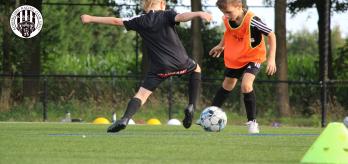
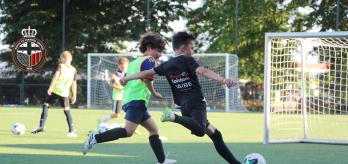
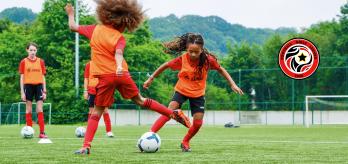
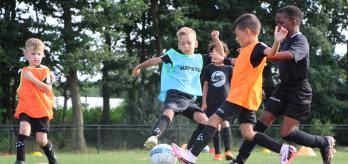

.variant64x64.jpg)

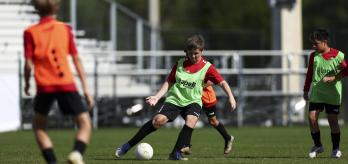
.variant348x164.jpg)
